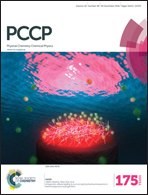Impact of the molecular structure and adsorption mode of D–π–A dye sensitizers with a pyridyl group in dye-sensitized solar cells on the adsorption equilibrium constant for dye-adsorption on TiO2 surface
Abstract
D–π–A dyes NI-4 bearing a pyridyl group, YNI-1 bearing two pyridyl groups and YNI-2 bearing two thienylpyridyl groups as the anchoring group on the TiO2 surface have been developed as dye sensitizers for dye-sensitized solar cells (DSSCs), where NI-4 and YNI-2 can adsorb onto the TiO2 electrode through the formation of the coordinate bond between the pyridyl group of the dye and the Lewis acid site (exposed Tin+ cations) on the TiO2 surface, but YNI-1 is predominantly adsorbed on the TiO2 electrode through the formation of the hydrogen bond between the pyridyl group of the dye and the Brønsted acid sites (surface-bound hydroxyl groups, Ti–OH) on the TiO2 surface. The difference in the dye-adsorption mode among the three dyes on the TiO2 surface has been investigated from the adsorption equilibrium constant (Kad) based on the Langmuir adsorption isotherms. It was found that the Kad values of YNI-1 and YNI-2 are higher than that of NI-4, and more interestingly, the Kad value of YNI-2 is higher than that of YNI-1. This work demonstrates that that for the D–π–A dye sensitizers with the pyridyl group as the anchoring group to the TiO2 surface the number of pyridyl groups and the dye-adsorption mode on the TiO2 electrode as well as the molecular structure of the dye sensitizer affect the Kad value for the adsorption of the dye to the TiO2 electrode, that is, resulting in a difference in the Kad value among the D–π–A dye sensitizers NI-4, YNI-1 and YNI-2.


 Please wait while we load your content...
Please wait while we load your content...